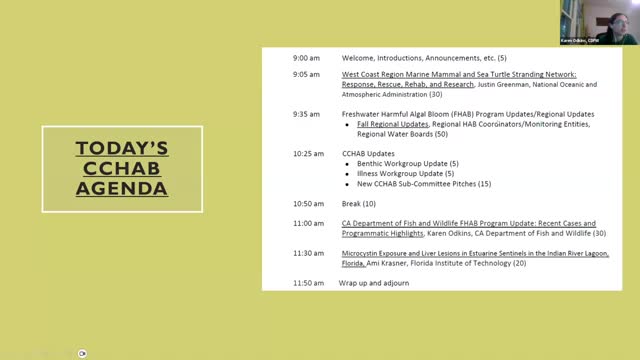Marine mammal rescue network faces crisis amid strandings
December 05, 2024 | California Water Quality Monitoring Council, Boards and Commissions, Executive, California
This article was created by AI summarizing key points discussed. AI makes mistakes, so for full details and context, please refer to the video of the full meeting. Please report any errors so we can fix them. Report an error »

In a virtual meeting held on December 5, 2024, Justin Greenman, a representative of the West Coast marine mammal and sea turtle stranding network, shared critical insights into the ongoing challenges faced by marine wildlife along California's coast. As he spoke from his home, the urgency of the situation was palpable, particularly in light of recent harmful algal blooms that have significantly impacted local marine life.
Greenman explained that the stranding network is dedicated to the response, rescue, rehabilitation, and research of marine mammals and sea turtles that are stranded—either alive and in need of help or deceased. The network spans California, Oregon, and Washington, comprising over 30 organizations, including nonprofits, universities, and aquariums. While primarily focused on marine mammals, the network also responds to sea turtle incidents, albeit less frequently.
A significant portion of Greenman's presentation detailed the alarming rise in strandings due to harmful algal blooms, particularly in the summers of 2022, 2023, and 2024. These blooms have led to a surge in cases of domoic acid poisoning, which affects the neurological health of marine animals. In 2023 alone, the network recorded over 1,000 stranded sea lions and 120 dead common dolphins, a staggering increase that raised concerns among responders and the public alike.
Greenman highlighted the network's response protocols, which include assessing the condition of stranded animals, documenting their health, and determining whether they require rescue or rehabilitation. He noted the complexities involved in these efforts, such as limited funding, personnel shortages, and the physical challenges of accessing certain coastal areas. The network's capacity to respond effectively is often hindered by these constraints, especially during peak stranding events.
One innovative solution discussed was the establishment of a resting station in Los Angeles County, designed to provide a safe space for distressed sea lions away from public interaction. This initiative aimed to reduce human-animal conflicts while allowing the animals to recover in a controlled environment.
As the meeting concluded, Greenman emphasized the need for ongoing research and funding to address the increasing frequency of harmful algal blooms and their impact on marine wildlife. The stranding network's ability to adapt and respond to these challenges will be crucial in safeguarding the health of California's marine ecosystems in the years to come.
Greenman explained that the stranding network is dedicated to the response, rescue, rehabilitation, and research of marine mammals and sea turtles that are stranded—either alive and in need of help or deceased. The network spans California, Oregon, and Washington, comprising over 30 organizations, including nonprofits, universities, and aquariums. While primarily focused on marine mammals, the network also responds to sea turtle incidents, albeit less frequently.
A significant portion of Greenman's presentation detailed the alarming rise in strandings due to harmful algal blooms, particularly in the summers of 2022, 2023, and 2024. These blooms have led to a surge in cases of domoic acid poisoning, which affects the neurological health of marine animals. In 2023 alone, the network recorded over 1,000 stranded sea lions and 120 dead common dolphins, a staggering increase that raised concerns among responders and the public alike.
Greenman highlighted the network's response protocols, which include assessing the condition of stranded animals, documenting their health, and determining whether they require rescue or rehabilitation. He noted the complexities involved in these efforts, such as limited funding, personnel shortages, and the physical challenges of accessing certain coastal areas. The network's capacity to respond effectively is often hindered by these constraints, especially during peak stranding events.
One innovative solution discussed was the establishment of a resting station in Los Angeles County, designed to provide a safe space for distressed sea lions away from public interaction. This initiative aimed to reduce human-animal conflicts while allowing the animals to recover in a controlled environment.
As the meeting concluded, Greenman emphasized the need for ongoing research and funding to address the increasing frequency of harmful algal blooms and their impact on marine wildlife. The stranding network's ability to adapt and respond to these challenges will be crucial in safeguarding the health of California's marine ecosystems in the years to come.
View full meeting
This article is based on a recent meeting—watch the full video and explore the complete transcript for deeper insights into the discussion.
View full meeting
